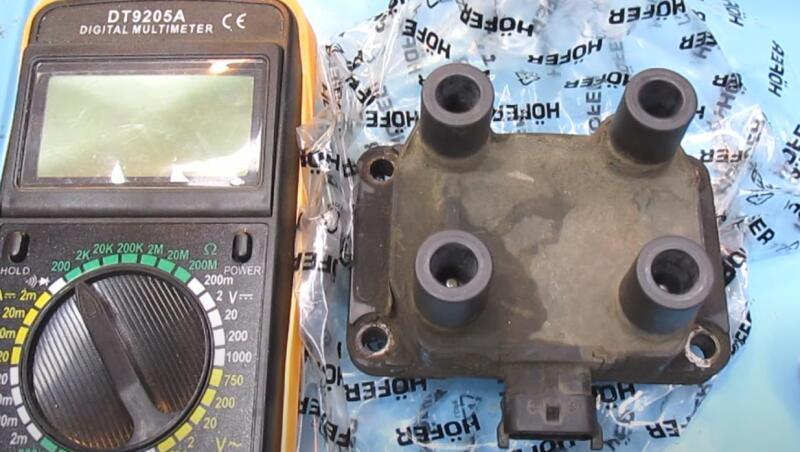Causes
They can be "counted on the fingers": open circuit, short circuit and breakdown of the insulator. At the first stage, it is not so easy to notice a malfunction: most often it manifests itself under load: for example, when overtaking, when you need to quickly accelerate the car. And with rare and short trips, it’s generally impossible to notice anything specific - usually interruptions in the operation of the engine are attributed to an unheated engine.
 The glow of this light bulb causes an alarm. Photo: YouTube.com
The glow of this light bulb causes an alarm. Photo: YouTube.comAt the initial stage, the Check Engine indicator may not even blink: online diagnostics will be required to identify the malfunction.
In accordance with physical laws (which no one has canceled!), The current follows the path of least resistance, which also applies to the ignition spark. Therefore, if she has already found some “own”, shorter path, be sure that she will not turn off from there.
High humidity
It happens that in dry weather everything is fine, but as soon as it started to rain, the car "like" starts to tweak. The same thing can happen in winter - the snow melts quickly, in contact with the parts under the hood, where it penetrates through the radiator grille, joints of body elements, from below.
 Of course, it is necessary to remove snow from the hood, but it is better not to do it with a shovel. Photo: YouTube.com
Of course, it is necessary to remove snow from the hood, but it is better not to do it with a shovel. Photo: YouTube.comHowever, moisture is not the only reason why a candle is “looking for another way”.
Frost
A cold engine is more difficult to start. To do this, the ECU enriches the mixture (manually, on carbureted cars, they used to pull out the “suction”). And it's not easy to ignite it. If the candle does not immediately cope with the problem and does not ignite gasoline with air, then the first one fills it. As a result, the spark cannot form between the electrodes, and it looks for an easier way: for example, through the coil insulator. It seems that all the reasons for its failure are described. However, it only seems so - let's move on!
Candles
This is where the most annoying thing is when you change the coil over and over again, in which the insulator is constantly broken. The car owner curses the manufacturers by buying the most expensive spare part, but the result is the same. And the reason is simple: over time, the gap between the electrodes at the candle becomes larger, because they burn out. Naturally: the resistance between the "pieces of iron" increases and the spark is "reluctant" to go there. As a result, its coil "sends" to the "mass" in the shortest way - through its insulator.
 The gap between the electrodes is best checked personally with a special probe. Photo: YouTube.com
The gap between the electrodes is best checked personally with a special probe. Photo: YouTube.comSome of the fans of iridium candles may object: they say, expensive parts last longer. Yes, it is, provided that you did not buy a fake. And falsifying expensive goods for scammers is another temptation! If ordinary inexpensive candles work normally, it is better to put them. Let you have to change it more often (no later than 30 thousand km), but you will save the coil.
Engine compartment
This refers to the observance of cleanliness under it. Some believe that washing the engine compartment only harms: they say, because of it, there are short circuits in the electrical wiring. This is not at all true: a well-performed operation will never harm. Of course, if you climb under the hood with a high-pressure washer and “wash” the generator and coil, you are unlikely to like the behavior of the car after such a “care”. Iskra just "loves to run" through the mud.
 Under the hood should be dry and clean. Photo: YouTube.com
Under the hood should be dry and clean. Photo: YouTube.comCar owners who have a coil screwed directly to the engine must carefully monitor the cleanliness. Constant shaking, dirt and temperature changes simply “oblige” a spark to slip past. And do not forget: in the city, dirt is mixed with reagents in winter that promote corrosion, which reduces the life of the engine compartment "residents".
What are coils
Once upon a time, only one type of spare part dominated - a common one for all cylinders. This is a pair of windings on a metal core. To prevent the product from overheating, it is sometimes filled with transformer oil.
 One ignition module (coil) for 4 cylinders. Photo: YouTube.com
One ignition module (coil) for 4 cylinders. Photo: YouTube.comToday, individual coils are more common: that is, each sends an explosive impulse to its cylinder.
 Individual coil for 1 cylinder. Photo: YouTube.com
Individual coil for 1 cylinder. Photo: YouTube.comSuch a system is popular due to the following advantages:
✅ if one coil fails, the motor continues to work
✅ reliability due to the absence of an ignition distributor
✅ longer service life associated with dividing the load into four (or more) parts
✅ reduction of radio interference
There is another, intermediate option (rare) - dual coils. Here, each of them sends explosive pulses to a pair of cylinders.
Signs of breakage
One of them has already been mentioned: “triple”, which can take place after the engine warms up, as well as the Check Engine warning light. Other hints:
✅ increased fuel consumption: you need to put more pressure on the gas
✅ floating idle after the first start up to the stop of the internal combustion engine
✅ jerks when driving, power failures
✅ deafening exhaust from the muffler, accompanied by black smoke and the smell of gasoline
The on-board computer, if any, can tell you about a coil malfunction. The display will show a message about a "misfire" in a particular cylinder. Unfortunately, all of the above signs can also indicate malfunctions of other components, internal combustion engine parts. Therefore, it is worth turning to more specific methods for detecting a breakdown.
How to identify a malfunction
The first thing to do is to conduct an external inspection. On a broken coil, dark paths can be seen along which a spark “runs”. The current can also follow traces of oil, dirt on the body of the part. But far from always a malfunction is determined visually: a crack can also be microscopic in size. If the engine coils are separate for each cylinder, it is possible to identify a non-working one by mutual replacement. The item in a "single copy" is checked with an ohmmeter. It is necessary to measure the resistance of the primary and secondary windings. In the first case, connect the tester probes to the connectors that are supplied with 12 V. The resistance value is from 0,4 to 7 ohms.
 Checking the primary winding, the probes touch: central - right and central - left. Photo: YouTube.com
Checking the primary winding, the probes touch: central - right and central - left. Photo: YouTube.comThe secondary winding has immeasurably more turns and therefore its resistance is in the range from 100 to 500 kOhm (one probe to ground, the second to the output to the explosive). And yet, the most effective method of checking the performance of a “single” ignition coil is to replace it with a known good one.
Prevention and checks
The part is not worth much. However, if it breaks down often (every couple of seasons, or even more often), there is reason to think.
 There are, of course, specialists who restore coils. But is it worth it? Photo: YouTube.com
There are, of course, specialists who restore coils. But is it worth it? Photo: YouTube.comIt makes no sense to repair the spare part. You can, of course, wrap it with electrical tape, fill it with "epoxy", but all this is only a respite from a breakdown. And it usually happens on the road at the most inopportune time and in the same place.
Initially, remember when the last time you changed the candles. It is not difficult to check their performance: remove the explosive wires from each cylinder in turn with the engine running.
 The optimal location of the BB wires is so that they don’t touch anything anywhere. Photo: YouTube.com
The optimal location of the BB wires is so that they don’t touch anything anywhere. Photo: YouTube.comIf the motor began to work intermittently at this moment, everything is fine. In the case when there are no changes, the candle must be replaced. But if they have been used for more than 30-40 thousand kilometers, they need to be changed anyway, even if the test “says” that everything is in order. Sometimes the reason may lie in the BB wires, which, under certain conditions, “are also not averse” to breaking through to ground.










